Take a photographic trip to Barter Island, Alaska and see photos of polar bears and arctic foxes sharing the remains of the whale bones.
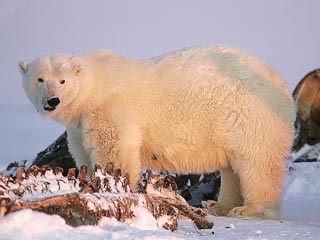
Copyright © Andy Long
This spine is mine!
Come late August and early September, polar bears begin congregating on the barrier islands off Barter Island in northern Alaska. They sit and wait. So do the residents of the town of Kaktovik. Both are waiting for the same thing–whales. The native Inupiat villagers are allowed to take up to three whales beginning September first–to provide meat, skin and blubber for the three hundred mostly native residents. The bears wait for the leftovers.
The scene has played out for more years than anyone can remember and will continue for many years to come. What might change is the access granted to photographers to get fairly close to the action of the bears on the bone pile once most of the whale meat has been distributed to the people. Word is that a fence will be built next year to hold people farther back. The fence won’t mean the end of good photography, though. Licensed native guides can be hired to take photographers around the area in boats, offering wonderful shots of the animals that come for a free meal before the winter months when they head out onto the pack ice in search of seals
The fence is intended to correct problems that have occurred when people have approached the bears too closely. A native guide told me he has seen someone in a vehicle drive within several feet of a bear that was sleeping next to the bone pile and honk his horn to get the bear to wake up and move around for photos. There are also numerous images on websites of a person being chased around a vehicle by a disgruntled bear. I witnessed one incident firsthand as I watched a person bouncing all over the place looking for both bears and foxes, pushing them away from the vicinity. Because of this kind of folly, the U.S. Fish and Wildlife Service, which has an office in town, is resorting to the construction of the fence. The thoughtlessness of a few will make it more difficult for the many that go about photographing wildlife in a proper way.
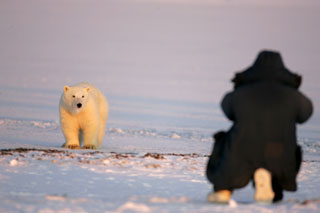
Copyright © Andy Long
Too Close!
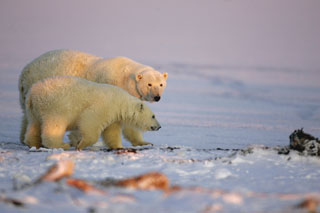
Copyright © Andy Long
Dinner has been served!
Why the gathering at Kaktovik? Polar bears have great memories, so they remember the time and place where food was available and return to that same spot the next year at the same time. This is why this small native village has become a consistent place to view and photograph these great white beasts in the wild. While most of the action is fairly predictable, hardly any two years are the same. The biggest factor is when the native Inupiats are able to make a kill of their first whale of the season. Although numerous bears show up before the first kill, the largest congregation does not occur until one has been brought on land.
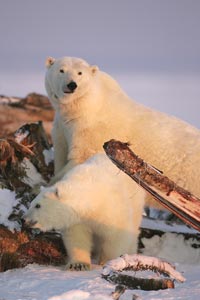
Copyright © Andy Long
Learning to hunt!!!
The end of the action changes every year as well. While the bears will hang around and forage on the carrion until there’s nothing left, if ice in the Beaufort Sea forms early they will depart to start their hunt for their main food source–seal. This particular year, a large mass of ice broke free from northwestern Canada and floated into the area, sending a majority of the bears onto the pack ice. But, as any wildlife photographer can attest, you need only one or two cooperative subjects to make a good shoot.
The combination of polar bears and arctic foxes is a unique one. It would seem a fox would make a nice morsel for the bears. This is not the case. Polar bears are concerned with eating as much fat and blubber as possible. Leftover meat from the whalebone pile is there for the fox to consume after the bears have finished their portion. This is also true when the bears head out onto the pack ice. When the bears catch a seal, they strip away the skin and blubber, leaving the remainder of the carcass behind for the foxes to clean. If it’s hungry enough, though, a bear will go after a fox, but bears don’t have a high success rate in such a hunt because of the speed and agility of Arctic foxes.
Foxes and polar bears also make odd but interesting play partners. While a mother polar bear and her young cub were working the bone pile, the cub spotted a couple of Arctic foxes. He started chasing them. Out on the ice, the young bear would scurry about after the foxes that had more maneuverability than he did. As a fox would cut and make a sharp turn, the bear would go sliding as he tried to slow down enough to change directions. Disinterested herself, the mother bear turned a blind eye to the action and kept on searching for scraps to eat at the pile of bones. Eventually, though, she took off after the youngster, so it wouldn’t roam off too far. (The action was too far away for me to get great shots, but it was fun to watch.)
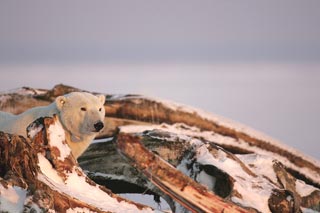
Copyright © Andy Long
So much from which to choose!
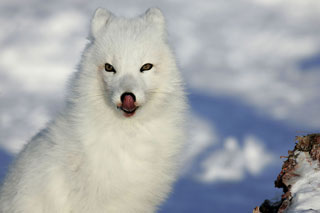
Copyright © Andy Long
Nose licking good!
When they were at the pile with no bears in sight, the foxes would be very cautious about their movement. However, even if a bear arrived, it would take him about five minutes to lumber across the ice that had formed between the barrier island and the spit where the bone pile was located.
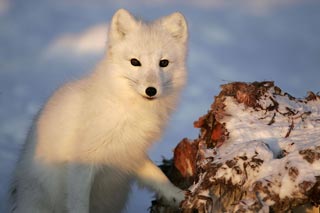
Copyright © Andy Long
Pose & smile for the camera.
Thus, the foxes seemed more concerned about a possible invasion by other foxes that might discover the spot they had found for a good meal, which for several of them was inside the base of the vertebrae where they could reach the marrow.
Although they were feasting almost two feet inside the bones, they would eat for only about five seconds or so before they would pop their heads out to look for intruders.
This action might repeat itself for a good period of time, allowing a photographer to set up nice shots. Human presence had little or no impact on these very small foxes. Every once in a while a person would try to sneak in on them, and they would dart off, only to return a short time later.
The behavior and mannerisms of a fox as it entered the area were interesting to observe. Some would stride right in and join the others, but some would take a very subordinate pose with their heads and tails down, showing they were submissive and not a threat to the others already there.
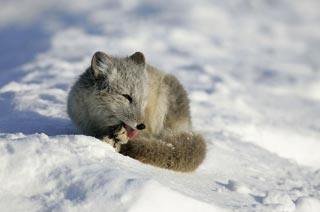
Copyright © Andy Long
Time to rest & clean up.
At this particular time of year when the foxes are feasting on leftovers, a variety of color phases are evident in their coats. Numerous had already turned completely white—the winter coat–while some still had the fully brown coat of summer. Another difference between their summer and winter coats is the thickness. With winter arriving, a much thicker coat is needed for the animals to make it through the extreme conditions they will have to withstand.
No matter what kinds of coats they’re wearing, shots of Arctic foxes in the wild are always a treat. But the main draw to the island remains the gathering of polar bears.
by Andy Long

Leave a Reply